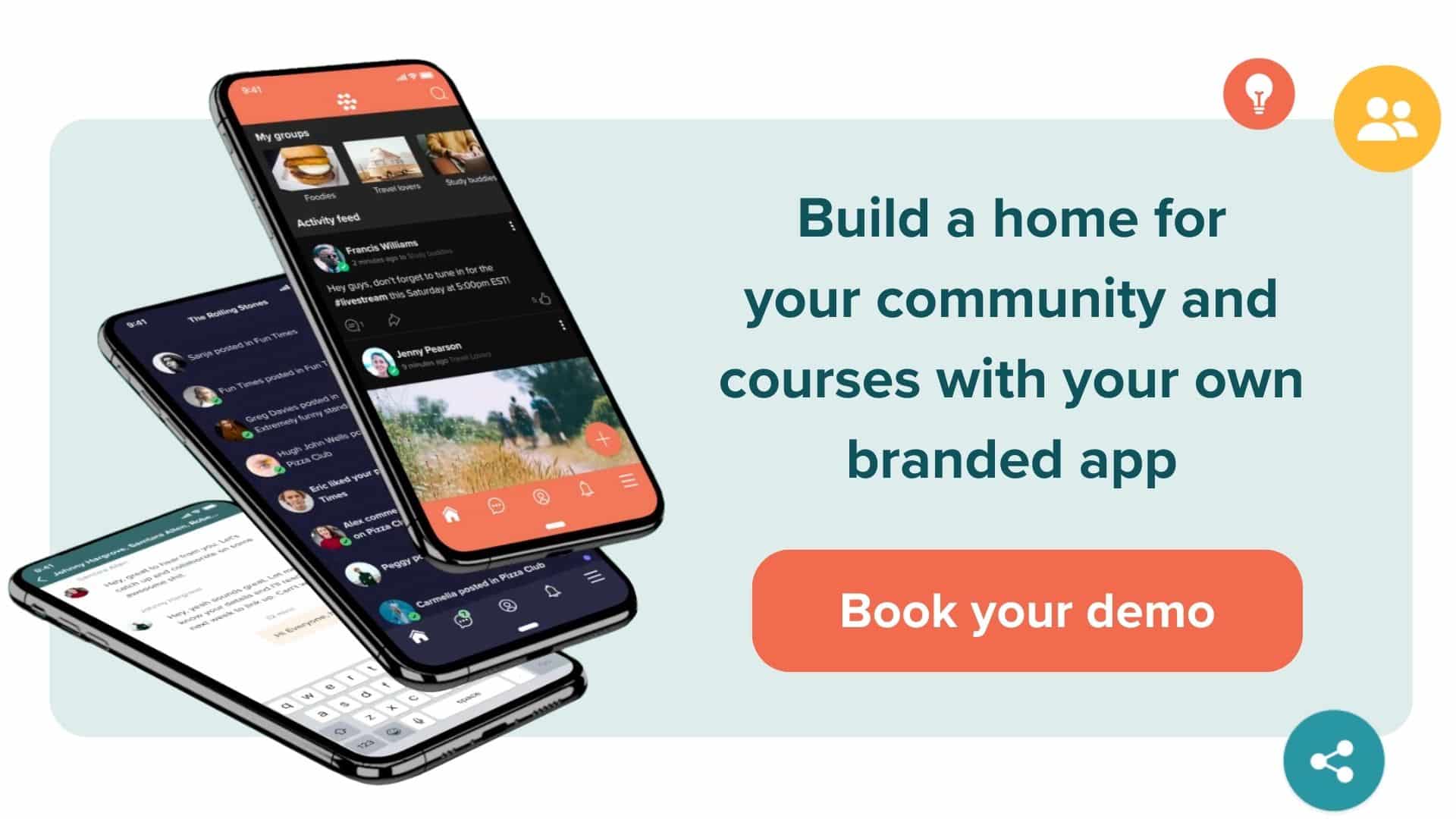Filter by Category
Filter by Category
Contents
Online learning is having a moment. A wealth of knowledge on pretty much any topic imaginable is sitting at our fingertips. However, the true potential of digital education is realized when it’s coupled with the power of community.
Creating an engaging online learning community transcends geographical barriers, bringing together diverse minds and fostering a rich, collaborative learning environment. This community-centric approach not only enhances educational quality but also significantly boosts learner engagement and retention.
Our comprehensive guide delves into the steps to build a thriving online learning community around your courses, ensuring a harmonious blend of technology, collaboration, and interactive learning that resonates with the needs of modern learners.
What is an online learning community?
An online learning community is a dynamic virtual space where learners, educators, and experts converge to share knowledge, experiences, and resources.
It transcends traditional classroom settings, allowing for continuous interaction and collaboration regardless of geographical boundaries. And it enhances the digital learning experience by providing the motivation that comes from meaningful connections with other people on a similar path.
In these communities, members engage in discussions, collaborative projects, and knowledge exchange, fostering a sense of belonging and mutual support. This inclusive environment encourages active participation, nurtures diverse perspectives, and facilitates a deeper understanding of subjects through peer-to-peer learning and expert guidance.
Online learning communities thus play a pivotal role in enhancing the educational experience in the digital age.

Types of online learning communities
Online learning communities are as diverse as the learners they serve, each tailored to specific needs and interests. Here are some prominent types:
- Interest-based communities: These bring together individuals with shared hobbies or intellectual pursuits. They foster deep engagement as members are driven by passion.
- Academic subject communities: Focused on specific academic fields, these communities attract students and scholars for in-depth discussions, research collaborations, and knowledge sharing.
- Professional development communities: Professionals join these communities to enhance skills, stay updated with industry trends, and network with peers.
- Course-specific communities: Built around specific online courses, these communities support learners through course materials, discussions, and collaborative learning experiences.
- Problem-solving communities: Members collaborate to address specific challenges or projects, leveraging collective expertise and creativity.
- Social impact communities: United by a desire to effect change, these groups focus on social causes, advocacy, or volunteering, often integrating learning with action.
- Multicultural and language learning communities: These cater to learners from diverse cultural backgrounds or those looking to learn new languages, enriching understanding through cultural exchange.
- Tech and innovation communities: Ideal for those interested in technology and innovation, these forums are hubs for discussing emerging trends, sharing tech-related knowledge, and collaborating on new ideas.
Each type of community offers unique opportunities for growth, networking, and learning, catering to the varied interests and goals of online learners.

How to choose a platform to host your course community
Choosing the right platform to host your course community is crucial for fostering an effective and engaging online learning environment. Here are key considerations:
- User-friendly interface: Select a platform that is intuitive and easy to navigate for both instructors and learners. A user-friendly interface ensures a smoother learning experience.
- Customization and flexibility: Look for platforms that offer customization options to tailor the community space according to your course requirements and branding.
- Interactive tools: Essential features include discussion forums, live chat, video conferencing, and collaborative workspaces. These tools encourage active participation and interaction among community members.
- Mobile accessibility: With the increasing use of smartphones for learning, a mobile-responsive platform is essential to allow learners access anytime, anywhere.
- Analytics and reporting: Platforms offering detailed analytics help in tracking engagement, participation, and progress, providing valuable insights for course improvement.
- Data security and privacy: Ensure the platform adheres to data protection regulations and maintains the privacy and security of user data.
- Integration capabilities: The ability to integrate with other educational tools and resources can enhance the learning experience.
- Technical support and reliability: Reliable customer support and minimal downtime are vital to maintain the continuity of learning.
- Cost-effectiveness: Consider the pricing structure and ensure it aligns with your budget and the value it offers.
A platform like Disciple Media, for instance, aligns well with these criteria, offering a comprehensive, customizable, and user-friendly environment for hosting vibrant course communities.

Setting learning objectives and goals
Setting clear learning objectives and goals is pivotal in guiding the direction and effectiveness of an online learning community.
Start by defining what learners should know or be able to do by the end of the course. These objectives should be specific, measurable, achievable, relevant, and time-bound (SMART). For example, by the end of a digital marketing course, learners might be expected to develop and present a comprehensive social media strategy.
Additionally, set collaborative goals to foster community engagement, like group projects or peer review sessions. These goals should encourage interaction and knowledge sharing, enhancing the collective learning experience.
Remember, objectives and goals should align with the overall educational philosophy of the course and be periodically reviewed and adapted based on feedback and learning outcomes.

Break the ice
Member participation is the key ingredient to a successful community. As the community host, it is your role to encourage everyone to get involved.
Icebreaker activities can really help with building rapport and comfort within an online learning community. Start with simple introductions where members share their backgrounds, interests, and objectives for joining the course. Utilize interactive tools like discussion boards or live chat sessions for this purpose.
Here are five engaging icebreaker activity ideas for your online learning community:
- Virtual scavenger hunt: Create a list of common household items or digital assets for participants to find within a set time limit, fostering a lively and playful atmosphere.
- Photo sharing: Ask participants to share a photo related to a theme (e.g., favorite place, hobby) and discuss them in a group chat or forum.
- Skill swap: Members share a unique skill or knowledge they possess, promoting peer learning and showcasing diverse talents within the community.
- Dream vacation: Have each member describe their ideal vacation destination, which can lead to discussions about interests and experiences, building connections among members.
- Two truths and a lie: Ask members to share three statements about themselves, two of which are true and one which is fictional. Other community members then guess which of the statements are true and false.
These activities lay the foundation for a collaborative and supportive learning environment. Keep it appropriate and make it fun!

Create interactive content
Creating interactive content is crucial for engaging learners in an online community. Here are key strategies:
- Quizzes and polls: Integrate quizzes and polls related to course content. This not only reinforces learning but also adds a fun, competitive element.
- Discussion prompts: Post thought-provoking questions or topics for discussion. Encourage learners to express their opinions and respond to others’ viewpoints.
- Interactive videos: Use videos with embedded questions or prompts. These can pause at key moments to ask viewers to reflect or answer questions.
- Case studies and scenarios: Present real-life scenarios or case studies for analysis. This encourages critical thinking and helps learns see course concepts in action.
- Collaborative projects: Use tools that allow learners to work together on projects or assignments, promoting teamwork and practical application of knowledge.
Remember, the goal is to create content that not only informs but also actively involves your members in the learning process.
Encourage your members to participate
Encouraging active participation in an online learning community is essential for fostering a vibrant and interactive environment. Here are some effective strategies:
- Regular engagement prompts: Post regular prompts or questions to stimulate discussion and encourage learners to share their thoughts and ideas.
- Recognition and rewards: Acknowledge active participants with recognition or rewards, like digital badges or certificates, to motivate continuous engagement.
- Peer-to-peer encouragement: Foster a culture where members are encouraged to respond to and interact with each other’s posts, creating a supportive peer network.
- Inclusive activities: Design activities that cater to diverse learning styles and preferences, ensuring all members feel comfortable contributing.
- Feedback channels: Provide avenues for members to offer suggestions and feedback, demonstrating that their input is valued and considered in shaping the community experience.
As host, model the engagement that you hope to see in your community. If you show up consistently and create a lively, chatty environment, your members are far more likely to do the same.

Gather feedback and study your community analytics
Gathering feedback and studying analytics is a critical process for enhancing the effectiveness of an online learning community.
Regularly solicit feedback through surveys or interactive polls, focusing on the community’s content, engagement strategies, and overall learning experience. Encourage members to provide informal feedback in discussion forums or direct communications.
Simultaneously, leverage analytical tools to monitor user engagement metrics, such as participation frequencies, duration of activity, and interaction within discussion threads. Analyzing this data alongside member feedback will reveal valuable insights into the community’s performance and areas for improvement, ensuring a dynamic and responsive learning environment that continuously evolves to meet learners’ needs.

Make sure your platform is mobile accessible
Ensuring your platform is mobile-accessible is crucial in our on-the-go world. A mobile-friendly learning community enables learners to engage with content, participate in discussions, and collaborate with peers anytime, anywhere.
Disciple Media excels in this area, enabling you to create your own fully branded mobile app to host your courses, content and community. Send push notifications, live stream, review your student’s course progress and so much more with Disciple. This accessibility enhances learner convenience and engagement, ensuring that members of your community have uninterrupted access to learning resources and interactions.
By choosing a platform like Disciple Media, you’re not only embracing modern learning trends but also providing a versatile and inclusive learning environment for all community members.
Best practices for building a successful community around your online course
To ensure the success and vitality of your online learning community, it’s important to adhere to certain best practices. These guidelines help in creating an engaging, effective, and inclusive environment for all participants.
Best Practices:
- Foster an inclusive environment: Ensure your community welcomes and values diverse perspectives and backgrounds.
- Regular communication: Maintain consistent communication through newsletters, announcements, or regular discussion threads.
- Encourage collaboration: Create opportunities for peer-to-peer learning and group projects.
- Responsive feedback: Provide timely and constructive feedback to foster a supportive learning environment.
- Utilize multimedia content: Incorporate a variety of content formats, like videos, podcasts, and infographics, to cater to different learning styles.
- Promote active participation: Use gamification techniques and challenges to keep members engaged and motivated.
- Monitor and adapt: Regularly assess community engagement and content effectiveness, and be ready to adapt strategies based on feedback.
- Leverage technology: Use the tools available in platforms like Disciple Media to enhance the learning experience.
- Maintain privacy and security: Ensure that the platform adheres to data protection standards, respecting member privacy and security.
Implementing these best practices in your online learning community will not only enhance the learning experience but also foster a dynamic, supportive, and engaging environment for all members.

Case Study: A Year With My Camera
Emma Davies’ journey with “A Year With My Camera” exemplifies how a well-crafted online learning community can transform educational experiences. This case study showcases the evolution from a social media-based group to a thriving, independent online community using Disciple Media’s platform.
The challenge
Initially, Emma Davies utilized Facebook and Instagram to build a community around her photography workbook. However, she faced significant challenges with her content getting lost in ad-driven feeds and struggling with limited engagement.
The solution
Emma decided to create an exclusive online space owned by her, leveraging Disciple Media’s platform. This allowed her to sell courses and workshops directly, share content without moderation, and connect with photography enthusiasts in a troll-free, secure environment.
Growth and impact
- Active engagement: Post-switch, over half the community became actively engaged on a weekly basis, a significant increase from just 10% engagement on social media.
- Revenue and independence: Emma experienced a surge in revenue through in-app sales, highlighting the cost-effectiveness and administrative ease of using a dedicated platform.
- Community atmosphere: The platform facilitated a family-like atmosphere, highly interactive and welcoming for both beginners and advanced photographers.
Key takeaways:
- Flexibility of platform: The adaptability of Disciple Media’s platform was crucial in creating a space that catered to the specific needs of a photography community, combining galleries, forums, and group features effectively.
- Enhanced reach and control: Moving away from social media algorithms allowed for better reach and control over content and engagement, leading to an ever-expanding community.
- Creating a niche space: The ability to cater to diverse member types, from beginners to those with niche interests, fostered a unique and inclusive learning environment.
Emma Davies’ success with “A Year With My Camera” is a testament to the power of a dedicated, well-managed online learning community. By using Disciple Media‘s platform, she overcame the limitations of social media, enhanced learner engagement, and created an autonomous, thriving educational community.

Final words
In conclusion, building a successful online learning community requires thoughtful planning, strategic implementation, and a keen understanding of your learners’ needs.
By choosing the right platform, setting clear objectives, engaging in interactive activities, and adhering to best practices, you can create a vibrant and supportive learning environment.
Platforms like Disciple Media offer the necessary tools and features to make this process seamless and effective.
Remember, the strength of an online learning community lies in its ability to connect, engage, and enrich the educational experiences of its members, making learning a collaborative, dynamic, and accessible journey for all.
FAQs
What is an online learning community?
An online learning community is a digital platform where learners and educators collaborate, share knowledge, and engage in discussions to enhance the learning experience.
Why is mobile accessibility important for online learning communities?
Mobile accessibility ensures that members can engage with the community anytime and anywhere, enhancing flexibility and continuous learning.
How can I encourage participation in my online learning community?
Encourage participation by integrating interactive content, providing responsive feedback, and creating opportunities for collaboration and discussion.
What role does feedback play in an online learning community?
Feedback is crucial for adapting and improving the community based on the needs and experiences of its members.
Why should I choose a platform like Disciple Media for my learning community?
Disciple Media offers a user-friendly, customizable, and mobile-accessible platform with robust features to effectively manage and engage an online learning community.
See how a Disciple community
can fit your business needs
See how a Disciple community can fit your business needs
Related Articles
18 min read
How To Build Your Online Community From Scratch
Wondering how to create a community? How to turn your social media presence into a thriving online community? …
8 min read
How the Best Businesses Build Brand Communities (+Examples)
No matter the name of your brand, the industry you operate in, the products you make or the …
9 min read






